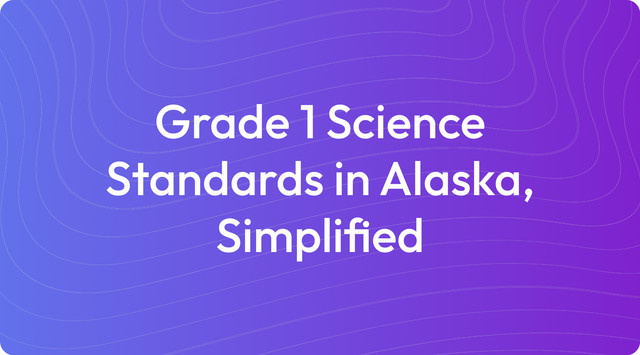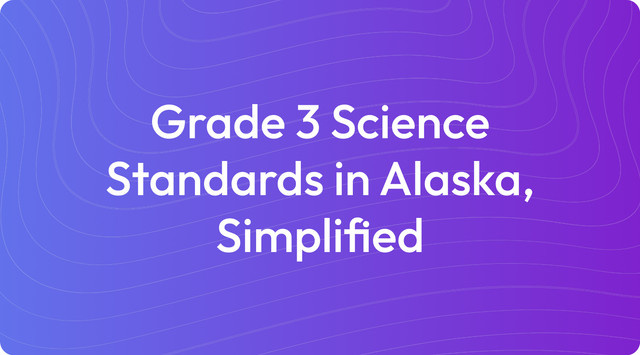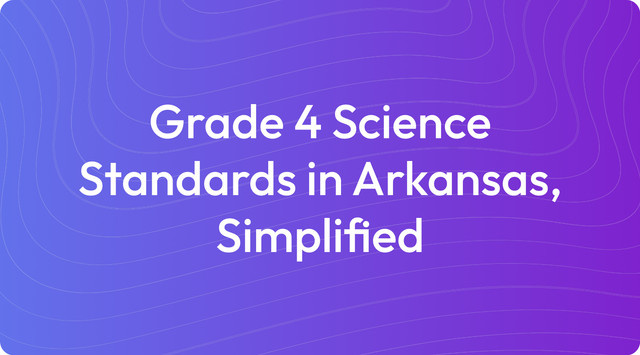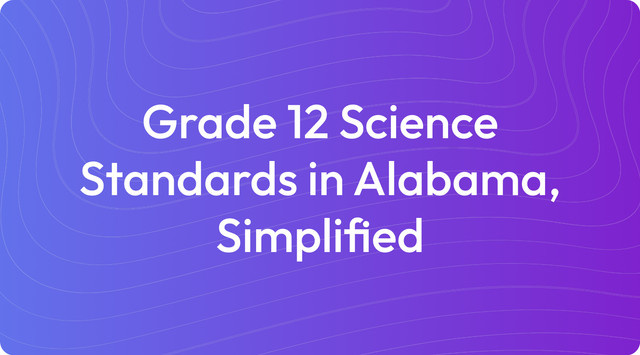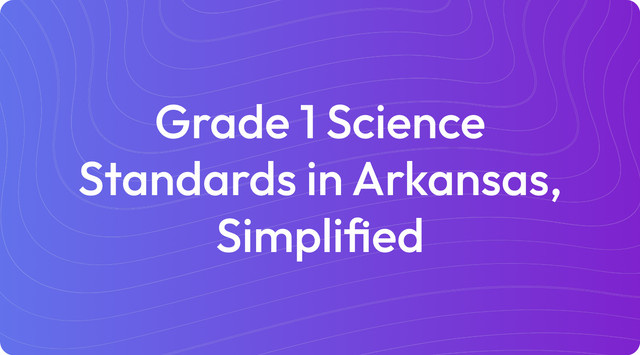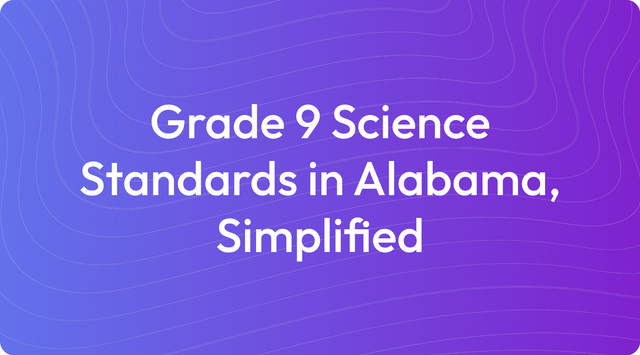Grade 6 Science Standards in Alabama, Simplified
Grade 6 science in Alabama focuses on Earth’s structure, weather, and energy basics. Check out the standards—read more on TeachShare!
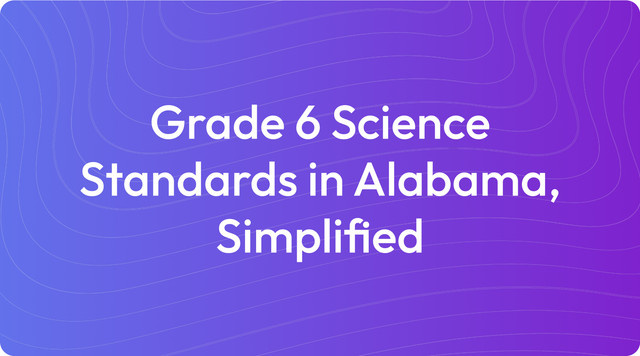
We understand that working with state standards can be a detailed process. To support your planning, we've broken down complex standards into more manageable guides. This approach helps clarify the core learning objectives for each grade level, making it easier to design effective instruction.
Education standards are learning goals that outline what students are expected to know by the end of a grade. For teachers, they provide a clear framework for curriculum planning without dictating specific instructional methods, offering you professional flexibility. For example, our simplified guide for Alabama's Grade 6 Science standards organizes expectations into key areas like Earth Science and Life Science, helping you focus on the core concepts for your students.
What Are Grade 6 Science Standards in Alabama?
The Grade 6 Science Standards for Alabama, based on the Alabama Course of Study: Science (2015), are designed to build a strong foundation in key scientific disciplines. These standards focus on hands-on investigations, critical thinking, and real-world connections to help students explore scientific phenomena. This approach prepares them for more advanced science concepts in later grades.
Here are the key areas and learning goals for sixth-grade science:
Key Areas of Grade 6 Science Standards in Alabama
1. Earth and Space Science (ESS): Earth's Systems and Resources
- Develop models to describe the cycling of Earth's materials and the flow of energy that drives these processes (e.g., rock cycle, plate tectonics, water cycle).
- Construct explanations for how geologic processes change Earth’s surface over time (e.g., plate movements, earthquakes, volcanic activity).
- Analyze and interpret data on natural hazards to predict future catastrophic events and inform community preparedness.
2. Life Science (LS): Ecosystems and Interdependence
- Analyze and interpret data to provide evidence for the effects of resource availability on organisms in an ecosystem.
- Develop and use models to describe the cycling of matter and flow of energy among organisms in an ecosystem.
- Design and evaluate solutions for maintaining biodiversity and ecosystem services.
3. Physical Science (PS): Matter and Energy
- Plan and conduct investigations to demonstrate how thermal energy affects particle motion and phase changes in matter.
- Develop models to describe the atomic composition of simple molecules and extended structures.
4. Engineering, Technology, and Applications of Science (ETS): Problem-Solving
- Apply scientific principles to design methods for monitoring and minimizing human impact on the environment (e.g., pollution, deforestation).
Key Learning Goals for Grade 6 Science in Alabama
- Model and Explain: Students create and use models to explain natural processes (e.g., cycling of matter, rock cycle, food webs).
- Analyze and Interpret Data: Students examine data on natural hazards, ecosystems, and energy flow to identify patterns and make predictions.
- Problem-Solving: Students design and test solutions to address environmental challenges and improve community resilience.
Sources: Alabama State Department of Education, Next Generation Science Standards.
Key Tested Standards
Assessments for Alabama's Grade 6 Science standards are designed to measure students' understanding of critical concepts in Earth and Space Science, Life Science, Physical Science, and Engineering Design. The key tested standards from the Alabama Course of Study: Science (2015) focus on a student's ability to analyze data, construct models, and solve real-world problems.
Key Tested Standards for Grade 6 Science in Alabama
1. Earth and Space Science (ESS): Earth's Systems and Resources
- Standard 1: Develop models to describe the cycling of Earth's materials and the flow of energy that drives these processes (e.g., rock cycle, plate tectonics, water cycle).
Why It’s Key: This standard assesses if students can grasp Earth's dynamic systems and the core processes that shape our planet's surface. - Standard 2: Construct explanations for how geologic processes, like plate movements, earthquakes, and volcanic activity, change Earth’s surface over time.
Why It’s Key: It requires students to explain how the planet's surface changes because of forces from within and outside the Earth. - Standard 3: Analyze and interpret data on natural hazards to predict future catastrophic events and inform community preparedness.
Why It’s Key: This focuses on using practical data to find patterns in natural disasters and suggest ways to lessen their effects.
2. Life Science (LS): Ecosystems and Interdependence
- Standard 4: Analyze and interpret data to provide evidence for the effects of resource availability on organisms in an ecosystem.
Why It’s Key: This standard checks for understanding of the connection between the availability of resources and how populations of organisms change. - Standard 5: Develop and use models to describe the cycling of matter and flow of energy among organisms in an ecosystem.
Why It’s Key: It assesses a student's ability to model how energy moves through an ecosystem, highlighting the roles of different organisms. - Standard 6: Design and evaluate solutions for maintaining biodiversity and ecosystem services.
Why It’s Key: This requires students to think critically and propose practical solutions for protecting ecosystems from threats.
3. Physical Science (PS): Matter and Energy
- Standard 7: Plan and conduct investigations to demonstrate how thermal energy affects particle motion and phase changes in matter.
Why It’s Key: It covers fundamental concepts in chemistry and physics, including how matter changes states and how heat is transferred. - Standard 8: Develop models to describe the atomic composition of simple molecules and extended structures.
Why It’s Key: This standard focuses on the building blocks of matter, which is crucial for understanding chemical reactions and properties.
4. Engineering, Technology, and Applications of Science (ETS): Problem-Solving
- Standard 9: Apply scientific principles to design methods for monitoring and minimizing human impact on the environment (e.g., pollution, deforestation, urbanization).
Why It’s Key: It challenges students to apply engineering principles to solve environmental issues, promoting creative problem-solving.
Why These Standards Are Key for Testing:
These standards are central to testing because they measure a student’s ability to think and act like a scientist. The focus is on whether students can:
- Analyze Data: For instance, reading charts about natural disasters, available resources, or changes in an ecosystem.
- Develop and Use Models: This includes building models that show the rock cycle, food webs, or the structure of molecules.
- Construct Explanations: An example is explaining how Earth is shaped by geological events or how heat changes matter.
- Solve Real-World Problems: This involves creating plans to lessen human effects on the environment or to help communities prepare for disasters.
Example Learning Objectives for Unit Planning
Learning objectives are clear, specific statements that describe what students should be able to do after a lesson or unit. They act as a roadmap for your instruction and help students understand the purpose of their learning. These objectives break down broader standards into measurable, student-focused goals.
To give you a practical starting point, here are examples of learning objectives for two Grade 6 Science standards. These are written in student-friendly language and align with the Alabama Course of Study: Science (2015).
Standard: Develop models to describe the cycling of Earth's materials and the flow of energy that drives these processes (e.g., rock cycle, plate tectonics, water cycle) (Standard 1).
Learning Objectives:
- I can explain how rocks change over time through the processes of the rock cycle (e.g., weathering, erosion, melting).
- I can describe how energy from Earth’s interior and the Sun powers processes like the rock cycle and water cycle.
- I can create a model to show how water moves through the water cycle, including evaporation, condensation, and precipitation.
- I can explain how plate tectonics cause changes in Earth’s surface, like forming mountains or causing earthquakes.
Standard: Develop and use models to describe the cycling of matter and flow of energy among organisms in an ecosystem (Standard 5).
Learning Objectives:
- I can explain how energy flows through an ecosystem, starting with the Sun and moving to producers, consumers, and decomposers.
- I can create a food web to show how plants and animals depend on each other for energy.
- I can describe how matter is recycled in an ecosystem through processes like decomposition.
- I can explain what happens to an ecosystem if one part of the food web is removed.
Key Changes & Updates
The Grade 6 Science Standards, based on the Alabama Course of Study: Science (2015), have been updated to support a more active and inquiry-based approach to learning. The goal is to help you guide students beyond memorization and toward genuine scientific thinking. This means a greater focus on hands-on investigations, critical thinking, and making connections between classroom concepts and the world around them.
These updates introduce a stronger emphasis on systems thinking, encouraging students to explore how different parts of an ecosystem or Earth's spheres interact. You'll notice lessons are now more frequently anchored in real-world situations, like analyzing data on natural hazards or designing solutions for environmental issues. This prepares students by having them practice data analysis, build models, and apply engineering design principles to solve practical problems.
Create with TeachShare
We know that understanding these standards is just the first step; the real work begins when you create lessons that bring them to life. Our platform is designed to support you in that process, helping you build high-quality, engaging materials that meet the specific needs of your students and curriculum. Let us help you save time on planning so you can focus on what you do best—teaching. Start creating standards-aligned instructional resources with TeachShare now.
Frequently Asked Questions
1. What key topics will my 6th graders learn in science?
According to the Alabama Course of Study, your students will explore four core areas of science:
- Earth and Space Science: This includes the rock and water cycles, plate tectonics, and analyzing natural hazards like hurricanes.
- Life Science: Students will study ecosystems, how energy flows through food webs, and the importance of biodiversity.
- Physical Science: This covers how thermal energy affects particles and leads to phase changes, along with the basics of atoms and molecules.
- Engineering Design: A practical component where students design solutions to reduce human impact on the environment.
2. How do the 2015 Alabama science standards change the way science is taught?
The Alabama Course of Study for Science shifts the focus toward a more interactive and applied approach. Instead of just memorizing facts, students are encouraged to think and act like scientists. The curriculum highlights:
- Hands-On Learning: Students actively investigate, collect data, and build models.
- Real-World Connections: Lessons are tied to practical issues like natural disasters and environmental management.
- Engineering Integration: Students get to design and test their own solutions to problems.
- Critical Thinking: The focus is on analyzing data and building explanations based on evidence.
3. What are some practical ways to make these science standards engaging for students?
We know that keeping students engaged is key to deep learning. Here are a few ideas that align well with the standards:
- Start with real-world questions like "What causes earthquakes?" to spark curiosity.
- Focus on hands-on activities such as building models, running experiments, or using digital simulations.
- Promote teamwork by having students collaborate on designing solutions to environmental challenges.
- Get outside to observe local ecosystems, weather patterns, or natural resources right in your community.
4. Why is there an engineering component in a 6th-grade science class?
Including engineering in the science curriculum helps bridge the gap between knowing and doing. It’s designed to show students how scientific concepts are used to solve tangible problems. This approach helps students develop creativity and critical thinking skills as they design, test, and refine their own solutions to challenges like pollution or resource management.
5. How is student understanding assessed under these standards?
Assessment moves beyond traditional tests and quizzes. Instead, you can gauge student understanding through their work on:
- Investigations and experiments where they apply the scientific method.
- Models and projects, such as creating a diagram of the water cycle or building a food web.
- Data analysis from their observations or provided datasets.
- Evidence-based explanations where they justify their conclusions.
Answer


